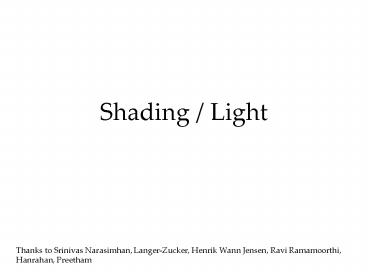Shading / Light - PowerPoint PPT Presentation
Title:
Shading / Light
Description:
Shading / Light Thanks to Srinivas Narasimhan, Langer-Zucker, Henrik Wann Jensen, Ravi Ramamoorthi, Hanrahan, Preetham – PowerPoint PPT presentation
Number of Views:129
Avg rating:3.0/5.0
Title: Shading / Light
1
- Shading / Light
Thanks to Srinivas Narasimhan, Langer-Zucker,
Henrik Wann Jensen, Ravi Ramamoorthi, Hanrahan,
Preetham
2
- Phong Illumination Model
See Shirley, Ch 10 and http//en.wikipedia.org/wik
i/Phong_shading
3
- Phong vs. Gouraud Shading
Key What is interpolated when shading a
triangle?
See Shirley, Ch 10 and http//en.wikipedia.org/wik
i/Gouraud_shading
4
A more general illumination function is needed to
capture the appearance of real-world objects
5
BRDF Bidirectional Reflectance Distribution
Function
source
z
incident direction
viewing direction
normal
y
surface element
x
Irradiance at Surface in direction
Radiance of Surface in direction
BRDF
6
Important Properties of BRDFs
source
z
incident direction
viewing direction
normal
y
surface element
x
- Rotational Symmetry
- Appearance does not change when surface is
rotated about the normal.
BRDF is only a function of 3 variables
- Helmholtz Reciprocity (follows from 2nd Law
of Thermodynamics) - Appearance does not change when source and
viewing directions are swapped.
7
Diffuse Reflection and Lambertian BRDF
8
Rendered Sphere with Lambertian BRDF
- Edges are dark (N.S 0) when lit head-on
- See shading effects clearly.
9
Specular Reflection and Mirror BRDF
source intensity I
specular/mirror direction
incident direction
normal
viewing direction
surface element
- Very smooth surface.
- All incident light energy reflected in a SINGLE
direction. (only when )
10
Specular Reflections in Nature
It's surprising how long the reflections are when
viewed sitting on the river bank.
Compare sizes of objects and their
reflections! The reflections when seen from a
lower view point are always longer than when
viewed from a higher view point.
11
Specular Reflections in Nature
12
Glossy Surfaces
- Delta Function too harsh a BRDF model
- (valid only for highly polished mirrors and
metals). - Many glossy surfaces show broader highlights in
addition to mirror reflection. - Surfaces are not perfectly smooth they show
micro-surface geometry (roughness).
13
Blurred Highlights and Surface Roughness
14
Phong Examples
- These spheres illustrate results from our simple
Phong Illumination model as lighting direction
and nshiny are varied
15
Those Were the Days
- In trying to improve the quality of the
synthetic images, we do not expect to be able to
display the object exactly as it would appear in
reality, with texture, overcast shadows, etc. We
hope only to display an image that approximates
the real object closely enough to provide a
certain degree of realism. Bui Tuong Phong,
1975
16
All components of Surface Reflection
17
(No Transcript)
18
(No Transcript)
19
With Fresnel Reflectance
Without Fresnel Reflectance
http//www.graphics.cornell.edu/westin/misc/fresn
el.html
20
Reflections on water surfaces - Glittering
21
Split off-specular Reflections in Woven Surfaces
22
Why does the Full Moon have a flat appearance?
- The moon appears matte (or diffuse)
- But still, edges of the moon look bright
- (not close to zero) when illuminated by
- earths radiance.
23
Why does the Full Moon have a flat appearance?
Lambertian Spheres and Moon Photos illuminated
similarly
24
Surface Roughness Causes Flat Appearance
Actual Vase
Lambertian Vase
25
Rendered Sphere with Lambertian BRDF
- Edges are dark (N.S 0) when lit head-on
- See shading effects clearly.
26
Surface Roughness Causes Flat Appearance
Increasing surface roughness
Lambertian model Valid for only SMOOTH MATTE
surfaces. Bad for ROUGH MATTE surfaces.
27
Modeling Rough Surfaces - Microfacets
- Roughness simulated by Symmetric V-groves at
Microscopic level. - Distribution on the slopes of the V-grove faces
are modeled. - Each microfacet assumed to behave like a perfect
lambertian surface. - For more information, look into the Oren-Nayar
Model
28
Why bother modeling BRDFs?Why not directly
measure BRDFs?
Measuring BRDFs
- True knowledge of surface properties
- Accurate models for graphics
29
Measuring BRDFs
- A full BRDF is 4-dimensional
- Simpler measurements (0D/1D/2D/3D) often useful
- Lets start with simplest and get more complex
30
Measuring Reflectance
0º/45º Diffuse Measurement
45º/45º Specular Measurement
31
Gloss Measurements
- Standardized for applications such as paint
manufacturing - Example contrast gloss is essentially ratio of
specular to diffuse - Sheen is specular measurement at 85
32
Gloss Measurements
- Haze and distinctness of image are
measurements of width of specular peak
33
Gonioreflectometers
- Three degrees of freedom spread among light
source, detector, and/or sample - Can add fourth degree of freedom to measure
anisotropic BRDFs
34
Image-Based BRDF Measurement
- Reduce acquisition time by obtaining larger
- (e.g. 2-D) slices of BRDF at once
- Idea Camera can acquire 2D image
- Requires mapping of angles of light to camera
pixels
35
(No Transcript)
36
(No Transcript)
37
(No Transcript)
38
(No Transcript)
39
(No Transcript)
40
(No Transcript)
41
(No Transcript)
42
(No Transcript)
43
Looking ahead Real objects have texture!
44
(No Transcript)
45
(No Transcript)
46
(No Transcript)
47
Materials Change with Time
48
Practice Problems
Sketch a picture of what you think the BRDF might
look like for a single incoming light direction
and a particular surface. Please assume an
incoming light direction 45 degrees from the
surface normal. Assume a surface with both
diffuse color and highlights, e.g. a green
pepper. Write notes to explain your
sketch. Are there types of materials for which a
constant is acceptable as a BRDF? What would
such a surface look like?
49
Practice Problems
Describe an experiment to measure the BRDF that
you sketched for the problem on the previous
slide. What data structure would you use to
store such a BRDF? Are there types of materials
for which a one-dimensional function is
acceptable as a BRDF? a two-dimensional
function? a three-dimensional function? When
do you need all four parameters to represent the
BRDF adequately? When might you need five
dimensions instead of four?































